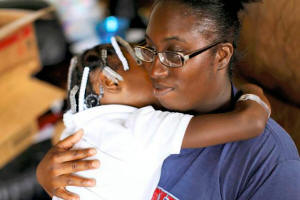|
U.S. cities move to curb lead poisoning
following Reuters report
 Send a link to a friend
Send a link to a friend
 [January 19, 2017]
By Joshua Schneyer and M.B. Pell [January 19, 2017]
By Joshua Schneyer and M.B. Pell
NEW YORK (Reuters) - Cities and towns
across the United States are taking action after a Reuters report
identified thousands of communities where children tested with lead
poisoning at higher rates than in Flint, Michigan.
From California to Pennsylvania, local leaders, health officials and
researchers are advancing measures to protect children from the toxic
threat. They include more blood-lead screening, property inspections,
hazard abatement and community outreach programs.
The University of Notre Dame is offering a graduate course to study and
combat local poisoning problems the report helped bring to light.
"This has just laid out that it's not just a Detroit issue, it's not
just a Baltimore issue," said Ruth Ann Norton, president of Green &
Healthy Homes Initiative, a Baltimore-based nonprofit. "This started
conversations with mayors and governors."
In an investigation last month, the news agency used census tract and
zip code-level data from millions of childhood blood tests to identify
nearly 3,000 U.S. communities with recently recorded lead poisoning
rates at least double those in Flint. More than 1,100 of these
neighborhoods had a rate of elevated blood tests at least four times
higher than in Flint.
A Reuters interactive map, built with previously unpublished data,
allowed users to track local poisoning rates across much of the country
for the first time. In many areas, residents and officials weren't
previously aware of the scope of local children's exposure. The
poisoning hazards include deteriorating lead paint, tainted soil and
contaminated water.

To read the December investigation and use the map, click here:
http://www.reuters.com/investigates/special-report/usa-lead-testing/
Flint's lead poisoning is no aberration, Reuters found, but one example
of a preventable health crisis that continues in hazardous spots in much
of the country.
Lead poisoning stunts children's cognitive development, and no level of
exposure is considered safe. Though abatement efforts have made
remarkable progress in curbing exposure since the 1970s, children remain
at risk in thousands of neighborhoods.
In South Bend, Indiana, for instance, the data showed several hotspots.
In one tract, 31.3 percent of small children tested since 2005 had blood
lead levels at or above 5 micrograms per deciliter, the Center for
Disease Control and Preventionís current threshold for elevated levels
in children under age 6. Children at or above this threshold warrant a
public health response, the CDC says. (GRAPHIC:
http://tmsnrt.rs/2iSFqm1)
Across Flint, 5 percent of children tested had high levels during the
peak of the city's water contamination crisis.
After Reuters published its findings, South Bend Mayor Pete Buttigieg
held a press conference with county health officials to address local
poisoning. Several actions followed:
* County health officials have begun a surveillance effortto track
childhood blood-lead testing, encouraging morescreening. * Officials
plan to press for an Environmental ProtectionAgency grant to boost
environmental testing and lead abatement. * Notre Dame is offering a
semester-long graduate levelclass for students to research the local
poisoning problem andassist health officials. A summer research program,
"Get theLead Out," will send students into homes to measure lead
inpaint, dust, soil and water and inform families about risks.These
programs will help pay for hundreds more childhood bloodlead tests,
after testing stalled due to funding shortfalls.
"Everything has moved into fast-forward pace here since your story,"
said Heidi Beidinger-Burnett, a county health board member and professor
at Notre Dameís Eck Institute for Global Health. "We are acting with a
sense of urgency because kids here depend on it."
Other officials in Indiana are exploring additional measures to protect
children. State Senator Jean Breaux introduced a bill this week to
compel the state health department to double blood lead screening rates
among Indiana children enrolled in Medicaid. The screenings are required
for Medicaid-enrolled children, but major testing gaps remain.
[to top of second column] |

Nayesa Walker speaks to a reporter in her home as she holds her
daughter Kaelynn Lott in East Chicago, Indiana, U.S. September 16,
2016. REUTERS/Michelle Kanaar/File Photo

CALIFORNIA REACTS
In Oakland, California, 7.57 percent of children tested in the
Fruitvale neighborhood had high lead levels, a result largely of old
lead paint or tainted soil.
Two Oakland council members introduced a city resolution Jan. 12
that, if approved, will require property owners to obtain lead
inspections and safety certifications before renting or selling
housing built before 1978, when lead paint was banned. Oakland would
also provide families in older homes with lead safety materials, and
urge more blood screening.
"We need to address that issue, that's the bottom line," said
councilman Noel Gallo, who grew up in Fruitvale.
Larry Brooks, director of Alameda County's Healthy Homes Department,
wrote in a San Francisco Chronicle editorial that "Oakland has
thousands of lead-poisoned children." Before the Reuters report, he
added, "whispers about potential lead poisoning in Oakland were
dismissed as an 'East Coast phenomenon' or a crisis contained to
Flint."
The Reuters analysis found high poisoning rates in spots across
Texas, where the office of Austin City Council member Delia Garza
said she may use the information to press for more aggressive lead
abatement measures. City officials are urging the state health
department to release more blood testing data.
Local data can detect clusters of poisoned children who remain
hidden in the broader surveys states usually publish. The news
agency obtained local data covering 21 states, and about 61 percent
of the U.S. population, through public records requests.
In the Dallas area, clean air advocacy group Downwinders at Risk is
holding an event to address lingering hazards, including shuttered
lead smelters. The group cited Reuters' work, which helped to
identify Dallas areas with high poisoning rates.(GRAPHIC:
http://tmsnrt.rs/2iSLxqj)
"Having five to six times the national average of high blood lead
readings in a zip (code) just south of downtown certainly has been
getting people's attention," said group director Jim Schermbeck.
In St. Joseph, Missouri, where testing data showed at least 120
small children have been poisoned within a 15-block radius since
2010, the city manager convened department heads to address the
problem. (GRAPHIC: http://tmsnrt.rs/2iSzl93)

Pennsylvania had the most census tracts where at least 10 percent of
children tested high for lead. In Warren, where the rate was as high
as 36 percent, the city manager said she's considering distributing
home-testing kits to families. County officials will meet to
consider several additional measures, including boosting blood
screening and increasing funding for prevention. (GRAPHIC:
http://tmsnrt.rs/2iSBOk0)
County Commissioner Jeff Eggleston said he wasn't aware of the full
scope of poisoning in Warren until the Reuters report. It hit close
to home. A few years ago, Eggleston said, his infant son was
poisoned by lead.
(Reporting by Joshua Schneyer and M.B. Pell. Editing by Ronnie
Greene)
[© 2017 Thomson Reuters. All rights
reserved.]
Copyright 2017 Reuters. All rights reserved. This material may not be published,
broadcast, rewritten or redistributed. |